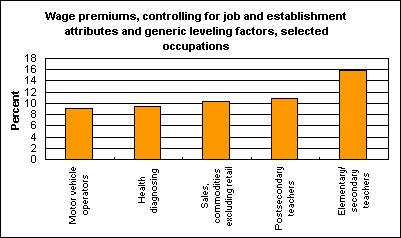February 15, 2000 (The Editor’s Desk is updated each business day.)
Wages, occupations, and job duties
It is common
knowledge that some occupations pay better than others. No one is
surprised to find that doctors and other health-diagnosing professionals
earn roughly twice as much as the average for all occupations. But what if
jobs with similar duties and responsibilities in distinct occupations are
compared?

[Chart data—TXT]
When such "generic leveling" is carried out, the list of the
five occupations in which the biggest wage premiums exist changes—sometimes
in surprising ways. The health-diagnosing occupations are still on the
list, but in fourth place rather than first.
Likewise, postsecondary teachers are on both lists, but after generic
leveling they are joined by their colleagues teaching at other levels of
education. Two other occupations—motor vehicle operators and sales,
commodities excluding retail—reach the top five after leveling despite
being well down on the unadjusted list.
The 10 generic leveling
factors used in this study are knowledge, supervisory controls,
guidelines, complexity, scope and effects, personal contacts, purpose of
contacts, physical demands, work environment, and supervisory duties. A
wage premium for an occupation describes the percentage difference between
that occupation’s wage rate and the rate for the average occupation.
The data upon which this analysis is based are products of the National
Compensation Survey. Find out more
in, "Using the National Compensation Survey to Predict Wage
Rates" (PDF 79K), by Brooks Pierce, Compensation and Working Conditions,
Winter 1999.
Of interest
Spotlight on Statistics: National Hispanic Heritage Month
In this Spotlight, we take a look at the Hispanic labor force—including labor force participation, employment and unemployment, educational attainment, geographic location, country of birth, earnings, consumer expenditures, time use, workplace injuries, and employment projections.
.
Read more »
